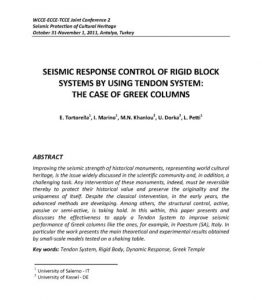
07 Mag Tendon System
SEISMIC RESPONSE CONTROL OF RIGID BLOCK SYSTEMS BY USING TENDON SYSTEM: THE CASE OF GREEK COLUMNS
The following lines are a summary of the paper by E. Tortorella, I. Marino, L. Petti (University of Salerno, Italy), M. N. Khanlou, U. Dorka (University of Kassel, Germany), presented at the Conference “Seismic Protection of Cultural Heritage” held in Antalya, Turkey in 2011.
Testimony of past classical stone architecture is present in Greek, Roman, Byzantine, Romanesque and Gothic monuments. The buildings, which remain nowadays, are only a few examples of the wide activity of this ancient culture, since many of them, characterized by high seismic vulnerability, have been located in areas of severe seismicity.
The ever present seismic threat to those monuments that have survived or been rebuilt has triggered an increasing interest of the scientific community in the conservation of these important historical structures. The difficulty to improve the seismic strength by preserving the cultural heritage is well known. Non-invasive strengthening methods are requested, since the uniqueness of the building must remain intact and any structural intervention must be essentially reversible to allow for a return to the original historic state, before intervention, at any time.
The paper focuses on monuments of classical Greek architecture: the temples, which are not only common in Greece, but also in its colonies, like those of Magna Graecia in the southern Italian peninsula. Starting around the 8th century B.C., these monuments were generally made of large structural stone elements that lie on top of each other without mortar, like drums in the case of columns.
This type of structures behaves as rigid-labile systems with unilateral constraints. In the case of the columns excited by seismic events, for example, the drums usually slide and/or rock, independently or in groups, with consequent permanent dislocations or even probable failure due to the overturning of the whole structure or one of its parts also for low seismic actions.
Recently some new concepts are being developed, among others, structural control concepts, which can be active, semi-active or passive. One of these possibilities is the Tendon System. The basic idea is to tie the loose stone blocks of a historical monument with tendons that run through their centres, but without continuous connections between tendons and stones (like grouting). Ideally, no pre-stressing is applied. Only during motions under earthquakes, forces develop in the tendons that limit these motions and prevent collapse. These forces can be controlled through special devices, like active hydraulic actuators or passive shape-memory alloy devices (SMA). Under regular loading conditions (dead load, wind, etc.), the historical state of stress is untouched. This system works particularly well in the case of a rigid body mechanism, like the one, which characterizes the Greek columns.
The tendon system can be removed any time easily, thereby returning the structure to its state before the intervention.
The paper describes the tendon control strategy in the case of Greek columns. In particular, the drums of the columns have been considered as held together through single cables running through the vertical axis, from the bottom to the top. On the top, the cables are connected to devices, which could control the axial tensile force and hence, provide a compressive pre-stress to the column to counteract seismic actions. The dynamic behavior of a rigid block with vertical load has been considered as a basic model to describe the behavior of such systems analytically. This analysis has been confirmed in preliminary shaking table tests on scale models at the University of Kassel representing the columns of the Temple of Neptune at Paestum, Italy.
Whereas the columns without Tendon System will collapse even under moderate ground motions, no collapse was observed with the Tendon System in place, even without initial pre-stressing. The obtained results clearly show the effectiveness of the control strategy presented here encouraging further in-depth studies for innovative applications of this system to monumental historic buildings.



Sorry, the comment form is closed at this time.